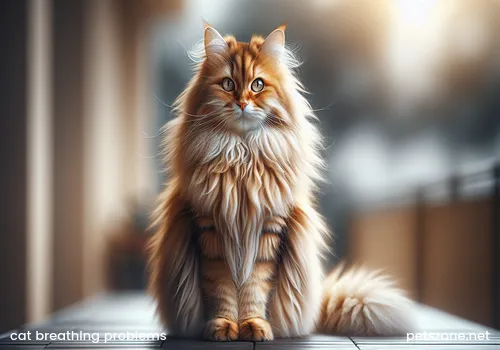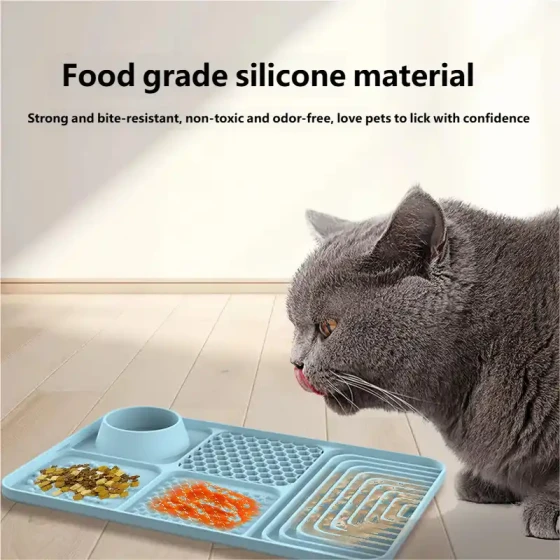The Cat Keeps Forcibly Exhaling Outward_Watch Out for These Abnormal Breathing Symptoms
The cat keeps forcibly "exhaling outward," sounding like the nose is forcefully breathing out. This situation worries many cat owners. It may be a sign that the cat is trying to clear foreign bodies from the respiratory tract or alleviate discomfort, medically often called "reverse sneezing" or related to various abnormal respiratory symptoms that need vigilance. Although occasional "exhaling" may be harmless, if it occurs frequently or with other symptoms, it may indicate underlying health problems, and it is best to consult a veterinarian promptly for diagnosis and treatment.
The cat "forcibly exhaling outward" or showing abnormal respiratory symptoms is not a trivial matter. There may be various underlying causes, ranging from mild nasal irritation to severe issues such as feline asthma, respiratory infections, or even heart disease. Understanding the possible meanings behind these abnormal respiratory symptoms is crucial for timely detection of health problems and avoiding treatment delays.

Common Manifestations of Abnormal Breathing Symptoms in Cats
A cat's breathing is usually quiet and steady, hardly noticeable. If you begin to notice your cat's breathing becomes obvious or exhibit any of the following abnormal signs, you should be alert:
- Forcibly exhaling outward: Unlike normal sneezing (forcefully pushing air out of the nasal cavity), this "exhalation" may be accompanied by specific head and neck postures, as if trying to expel something from the nasal cavity or throat. Sometimes the sound resembles a piglet grunt. This is called "reverse sneezing," a reflex of rapidly inhaling air to try to clear irritants from the back of the nasal cavity.
- Coughing: Like humans, cats can cough, which may be dry or wet. Cat coughing is often mistaken for vomiting or hairball coughing, but frequent or persistent coughing may signal respiratory disease.
- Wheezing: Hoarse or whistling sounds during breathing suggest airway narrowing or inflammation. Wheezing is one of the typical symptoms of feline asthma.
- Tachypnea (Rapid Breathing): Significantly increased respiratory rate while resting or calm. Normal resting rate for cats is about 20-30 breaths per minute; exceeding this range requires attention. You can count breaths by observing the rise and fall of the cat’s chest or abdomen.
- Dyspnea (Difficulty Breathing): Breathing becomes labored, requiring greater effort to expand or contract the chest and abdomen. It may be accompanied by open-mouth breathing (cats rarely breathe with mouths open unless very hot or extremely stressed), neck extension forward, or crouched posture. This is a very dangerous sign and requires immediate veterinary care.
- Visible abdominal breathing: Normally, the abdomen moves slightly during breathing, but if abdominal movement is pronounced, it indicates the cat is using abdominal muscles to assist breathing. This reflects respiratory difficulty.
- Other accompanying symptoms: Increased nasal or eye discharge (which may be clear, yellow, green, or even bloody), reduced appetite, lethargy, fever, abnormal gum or tongue color (such as bluish), can all signal respiratory system problems.
Possible Causes Behind Abnormal Breathing Symptoms in Cats
There are many causes of the above abnormal respiratory symptoms in cats, ranging from minor discomfort to life-threatening serious diseases. Common causes include:
- Reverse sneezing: This is one of the most common explanations for cats "forcibly exhaling outward." Usually triggered by irritation of the nasal cavity or throat, such as inhaling dust, pollen, foreign bodies (like cat litter dust, grass leaves), or sensitivity to environmental chemicals, perfumes, smoke, etc. Most cases last briefly and resolve spontaneously, considered a normal reflex. Short-nosed breeds (such as Persians) are more prone.
- Respiratory infections: Common causes of coughing, sneezing, and breathing difficulty in cats. May be caused by viruses (e.g., feline herpesvirus, calicivirus), bacteria (e.g., mycoplasma, chlamydia), or fungi. Infection causes airway inflammation and increased secretions, impacting normal breathing.
- Feline asthma: Similar to human asthma, a chronic inflammatory lung disease causing airway narrowing and spasms, leading to coughing, wheezing, and difficulty breathing. Allergens (pollen, dust mites, mold, smoke, cat litter dust) are common triggers.
- Pneumonia: Lung infection (bacterial, viral, or fungal) or aspiration injury causing pneumonia, resulting in respiratory difficulty, coughing, fever, and other symptoms.
- Cardiovascular disease: Heart problems, especially congestive heart failure, can affect blood circulation causing lung fluid accumulation, leading to coughing and breathing difficulty.
- Foreign bodies: Cats inhaling small objects like grass leaves or food particles, causing obstruction in the throat or airway, invoking severe coughing and breathing difficulty as the cat tries to expel the object.
- Parasites: Some parasites, such as lungworms, infect the cat’s respiratory system causing coughing.
- Pleural effusion or pneumothorax: Accumulation of abnormal fluid (blood, pus, chyle) or gas in the chest cavity compresses the lungs, impairing normal lung expansion, causing respiratory difficulty and coughing.
- Tumors or polyps: Tumors or nasopharyngeal polyps inside the respiratory tract may block airways causing breathing difficulty or coughing.
- Allergies: Besides asthma-related allergic reactions, other allergies may also cause respiratory symptoms in cats.
- Pain, stress, or anxiety: Severe pain, extreme stress, or anxiety can cause rapid breathing in cats.
- Anemia: Low red blood cell count reduces oxygen carrying capacity; cats compensate by breathing faster.
- Heat stroke: In hot environments, cats may breathe with an open mouth to dissipate heat, but this differs from pathological respiratory difficulty and typically resolves with cooling.
When Should You Take Your Cat to the Veterinarian Immediately?
Although occasional "exhaling" or mild symptoms may not be serious, if your cat exhibits any of the following, seek veterinary help immediately:
- Severe difficulty breathing, very labored, even open-mouth breathing.
- Respiratory rate consistently over 30-40 breaths per minute at rest.
- Gums or tongue appear blue or purple. This is a critical sign of hypoxia.
- Severe or persistent coughing or wheezing.
- Lethargy, loss of appetite, unwillingness to move or hiding.
- Coughing up blood or foam.
- Abnormal nasal or eye discharge.
- Sudden onset of abnormal breathing symptoms.
- Known respiratory conditions (e.g., asthma) suddenly worsening.
Remember, cats are masters at enduring pain and discomfort; they often hide their illnesses. Once you notice obvious abnormal respiratory symptoms, the condition may already be serious. Better to be cautious than neglectful.
How to Help a Cat Showing Abnormal Breathing Symptoms?
While waiting for veterinary care, you can do some things to help your cat, but do not perform treatment without veterinary guidance:
- Stay calm: Your nervousness affects the cat, making it more anxious and worsening breathing difficulty. Try to stay calm and soothe your cat with a gentle voice.
- Provide a quiet and comfortable environment: Place the cat in a quiet, warm, well-ventilated area, avoiding disruptions.
- Avoid stress: Do not force the cat to move or handle it excessively. Minimize unnecessary handling.
- Observe and record: Monitor the cat’s breathing rate, pattern, duration, and other accompanying symptoms. Recording a video can help the vet with diagnosis.
- Remove environmental irritants: If suspected environmental factors (dust, smoke, perfume) cause symptoms, try to eliminate such irritants. Consider using an air purifier or switching to dust-free cat litter.
For "reverse sneezing," gently massaging the cat's throat or briefly covering the nose can sometimes help restore normal breathing. But if the "exhaling" is frequent or persistent, veterinary examination is necessary.
How Do Veterinarians Diagnose and Treat?
Veterinarians assess the cat’s respiratory condition by detailed medical history and comprehensive physical examination. They may recommend additional tests to determine the cause:
- Chest X-ray: Helps evaluate lungs, heart, and chest cavity for abnormalities such as fluid, tumors, or inflammation.
- Blood tests: Check for infection, anemia, or systemic diseases that could cause respiratory issues.
- Airway sampling: In some cases, vets may collect airway secretions for analysis to identify infection sources.
- Heart ultrasound or ECG: Used to diagnose heart disease.
- Nasal or throat endoscopy: If foreign bodies or polyps are suspected.
Treatment depends on specific diagnosis; for example:
- Respiratory infections: Treatment varies according to pathogen type, including antibiotics, antivirals, or antifungals. Supportive care like humidifying air, clearing nasal secretions, and hydration is also important.
- Feline asthma: Usually treated with bronchodilators (to open airways) and corticosteroids (to reduce inflammation), administered orally or inhaled. Avoiding allergens is essential.
- Pneumonia: Requires targeted therapy, such as antibiotics for bacterial pneumonia. Severe cases may need hospitalization, fluids, and oxygen therapy.
- Pleural effusion: May require thoracentesis to drain fluid and treat underlying causes.
- Foreign body: May need to be removed by endoscopy or surgery.
Always follow veterinary instructions; never medicate cats yourself, especially with human drugs, to avoid danger.
Frequently Asked Questions
- What is the difference between "forcibly exhaling outward" and sneezing in cats? Sneezing is quickly pushing air out of the nasal cavity to clear foreign objects, while "forcibly exhaling outward" generally refers to reverse sneezing, where air is rapidly inhaled into the nasal cavity to clear irritants at the back of the nose.
- Should I worry if my cat occasionally reverse sneezes? If your cat only occasionally reverse sneezes briefly and shows no other discomfort symptoms, it is usually normal and not concerning.
- How to determine if a cat’s breathing rate is normal? When your cat is calm or sleeping, observe the rise and fall of the chest or abdomen; one rise and fall counts as one breath. Count the number of breaths in 30 seconds and multiply by two to get breaths per minute. Normal range is about 20-30 breaths per minute.
- Is open-mouth breathing normal for cats? Most cats breathe primarily through their noses. Except when very hot, after intense exercise, or under extreme stress, open-mouth breathing is usually a severe sign of respiratory difficulty requiring immediate veterinary care.
- My cat coughs like trying to vomit a hairball, is it really a hairball? Sometimes the cough sounds or actions resemble hairball vomiting, which can be confusing. However, frequent coughing without hairball expulsion or accompanied by other abnormal respiratory symptoms likely indicates other respiratory issues.
Conclusion
Cats continually forcibly exhaling outward or showing other abnormal respiratory symptoms are sending a health signal. As responsible pet owners, we should closely monitor our cats’ breathing and understand what these symptoms might mean. When cats show persistent, frequent, or severe abnormal breathing, remain calm and promptly seek professional veterinary help. Early detection, early diagnosis, and early treatment are key to ensuring cats’ respiratory health and improving their quality of life. Remember, any concerns about your cat’s health should be addressed by consulting a professional veterinarian for the most accurate advice and assistance.
-560x560.webp)

-560x560.webp)
